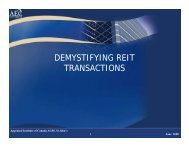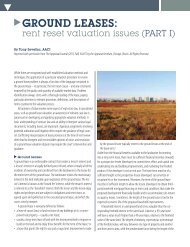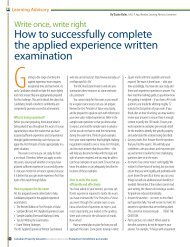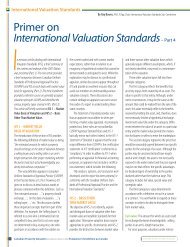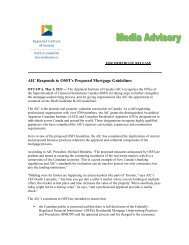Book 2 - Appraisal Institute of Canada
Book 2 - Appraisal Institute of Canada
Book 2 - Appraisal Institute of Canada
Create successful ePaper yourself
Turn your PDF publications into a flip-book with our unique Google optimized e-Paper software.
CRA Focus<br />
By Dianna LeBreton, CRA, Member CRA Focus Committee<br />
The inspection process<br />
One <strong>of</strong> the most important aspects<br />
<strong>of</strong> the real estate appraisal is the<br />
inspection. Whether inspecting new<br />
or existing, one- or two-family dwellings, threeor<br />
four-unit buildings, the appraiser must have a<br />
good overall knowledge <strong>of</strong> construction methods,<br />
building materials, plumbing, mechanical,<br />
electrical systems, and all products and systems<br />
relating to the structure. Keep yourself up to date.<br />
When you see something new or different, ask<br />
questions, or, when you get back to the <strong>of</strong>fice,<br />
look it up on the internet, it is a great source <strong>of</strong><br />
information and explanations.<br />
The process <strong>of</strong> a building inspection involves<br />
the collection <strong>of</strong> information and data pertaining<br />
to the subject property. A detailed inspection<br />
enables the appraiser to provide an accurate<br />
description <strong>of</strong> the property and allows you to<br />
conduct a thorough analysis <strong>of</strong> the subject. This<br />
results in a more accurate appraisal evaluation<br />
and provides the client with the necessary<br />
information to make an informed decision.<br />
When I begin an inspection, I advise the<br />
owner or whoever is present that I will start in<br />
the basement; work my way through the interior<br />
<strong>of</strong> the dwelling; then proceed with the exterior,<br />
and that I will most likely have some questions for<br />
them once I have seen the property. Sometimes,<br />
the owner may want to accompany me. This<br />
can be a distraction. Generally speaking, telling<br />
the person what I will be doing results in he or<br />
she giving me free reign <strong>of</strong> the dwelling. It is<br />
important to remember that most homeowners<br />
have never seen or had an appraisal done<br />
and have no idea what the process entails.<br />
Appraisers should view themselves as promoters<br />
<strong>of</strong> the pr<strong>of</strong>ession. Take time to ensure that the<br />
homeowner understands the value <strong>of</strong> having the<br />
home appraised. They may refer you to a friend,<br />
neighbour or relative once they understand the<br />
difference between you appraising their property<br />
and a realtor advising them <strong>of</strong> the value <strong>of</strong> their<br />
home.<br />
It is very important to be consistent, so perform<br />
all inspections in the same manner to ensure that<br />
nothing is missed. I like to start in the basement.<br />
The foundation is the bones <strong>of</strong> the structure and<br />
will tell you a lot about the building. What is the<br />
foundation type – poured concrete, block, cinder<br />
block, stone? Are there support beams? In an older<br />
dwelling, if you can see the actual frame, check<br />
for wood rot. Is there evidence <strong>of</strong> dampness and<br />
or mold?<br />
Next is the dwelling’s heating system. What<br />
type <strong>of</strong> heating system does the house have? Is<br />
it a forced air furnace, hot water boiler system,<br />
baseboard heating, or radiant heat? Is it fired by<br />
Canadian Property Valuation Volume 52 | book 2 | 2008 Évaluation Immobilière au <strong>Canada</strong> 29



